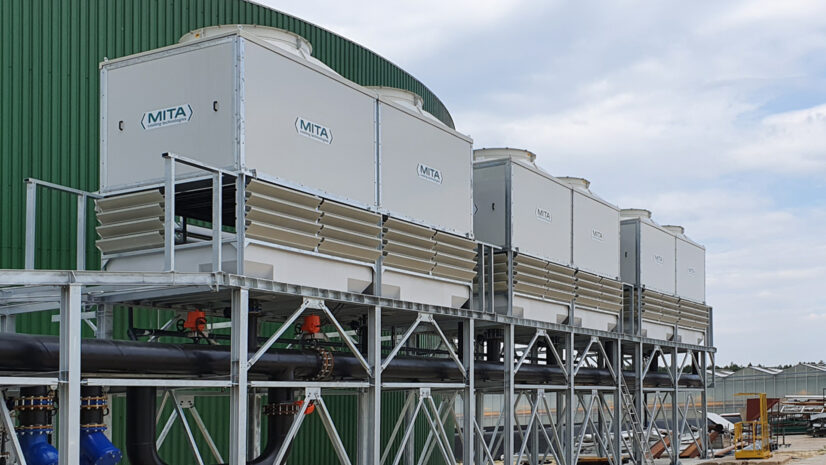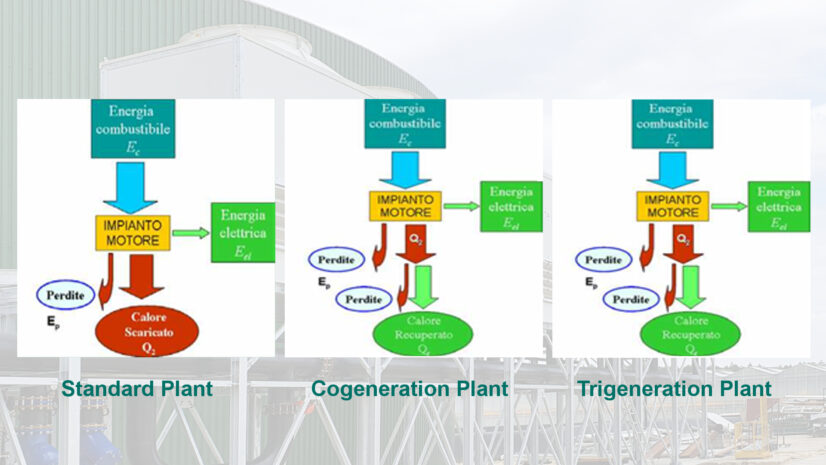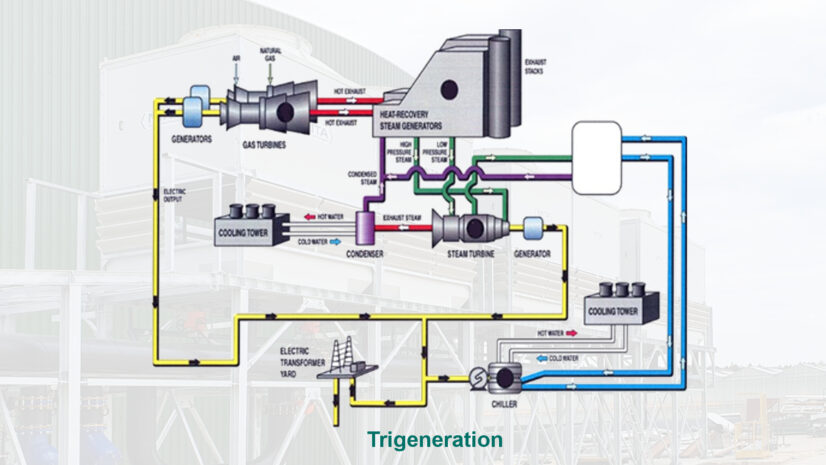Cooling Technologies for Cogeneration and Trigeneration

Energy sustainability has become an important focus for industry; cogeneration and trigeneration processes offer a unique opportunity to fulfill this vision. Cooling technologies for cogeneration and trigeneration are a very important enabler: evaporative cooling towers, dry coolers, and adiabatic coolers (or “adiabatic dry coolers”), contribute structurally to this combined production cycle and, through their individual technical characteristics, can give a major boost to the efficiency of the whole system.
Let’s see how and with what specifics.
1. Cogeneration and trigeneration plants: at a glance
Here is a brief background on the difference between cogeneration and trigeneration to define the scope well.

- Cogeneration (figure above) is a technology for the simultaneous generation of electrical and thermal energy (usually in the form of steam or hot water) from a single fuel source, such as natural gas or biomass. Practically speaking, cogeneration makes more efficient use of the energy contained in the fuel than the separate generation of electricity and heat.
- Trigeneration (figure above), on the other hand, allows simultaneous generation of electricity, heat and refrigeration (or air conditioning) using a single fuel source. We can therefore say that a trigeneration plant makes even more efficient use of the energy contained in the fuel than simple cogeneration: this is because it uses a larger heat component, rejected from the power generation process, to produce heat and cooling as well. This reduces the overall energy use of a building or industry and improves the overall efficiency of the entire system.
It is therefore clear that both cogeneration and trigeneration improve the energy efficiency of production processes.
2. The components of a trigeneration plant and cooling technologies.
We can see the trigeneration process as an extension of the cogeneration process. It is based on the efficient use of waste heat produced during electricity generation to also produce thermal energy and cooling.
It is now necessary to dwell on the main machines involved in the trigeneration process: this will also facilitate us understanding the contribution of cooling technologies.
- Gas generator or generators: these are fuel-fired (flue gas, methane, biomethane, …) and are used to produce electricity. However, they also produce waste heat.
- Condenser: is used in many power generation plants to condense spent process steam (e.g., from steam turbines), and convey it back to the heat exchanger.
- Heat exchangers (or heat recovery steam generators): they are an essential component in the trigeneration process. They are in fact the devices that recover the waste heat lost during the power generation process and transfer it to the utility in the form of heat. This heat will then be used downstream of the process for heating purposes or for domestic hot water production. This component is also present in the cogeneration process.
- Absorption chiller: it produces cold based on condensation and evaporation. It has an evaporator and a cooling coil that expands the refrigerant to produce cold. Unlike a mechanical compressor, the absorption chiller employs a heat source supplied directly by a burner or indirectly by steam, hot water or waste heat (flue gas): this can be done by state transformations of the refrigerant (water) in combination with lithium bromide used as an absorber. This component is present only in trigeneration processes.

In this complex process, cooling technologies intervene on two of the machines that make up the trigeneration cycle: the condenser and the absorption chiller, if water-cooled:
- Condenser cooling: it is an essential step to allow the spent steam to condense into water. Cooling technologies are used to remove the accumulated heat from the condenser coolant during its operation: the cooling water, taken from the condenser coils, undergoes heat dissipation through the various cooling technologies (by evaporative, dry or adiabatic process depending on the specific technology used). This is a stage present, as we have seen, in many power generation processes and in cogeneration and trigeneration processes.
- Absorption chiller cooling: the cooling water used to condense the refrigerant in the absorption chiller (let us emphasize again: in the case of water chillers, not air chillers) is sent to the cooling device. This may be, for example, an evaporative tower or an adiabatic dry cooler. There, the cooling water is exposed to the air, promoting heat exchange and allowing heat transfer to begin the process again.
3. Trigeneration plus cooling towers, adiabatic coolers or dry coolers: specific differences
We have seen that cooling technologies intervene in two specific stages of the trigeneration process: the condenser and the absorption chiller.
But which cooling technologies to prefer for these purposes among evaporative cooling towers, dry coolers, and adiabatic coolers? To answer this question, one needs to know the structural characteristics and advantages of each solution-the same ones that can be exploited for any other industrial or civil plant.
The specific advantages of each cooling technology depend on the needs of the application and the surrounding environmental conditions. Here is a description of the different advantages associated with each of the cooling technologies mentioned.
Cooling towers or Evaporative cooling towers
- High efficiency, due to the use of water in the system (and with the evaporation of a limited percentage of the water itself). This process achieves lower cooling temperatures than other technologies with extremely small machine surfaces, especially when compared with the following solutions.
- Very low energy use: because the cooling process relies primarily on the evaporation of water, evaporative towers require less energy than other cooling technologies.
- Zero water use: it is an all-air system 100% of the time.
- Reduced operating costs (in fact, no water control and treatment systems are needed).
- Optimization of water and energy use: during cold periods, adiabatic coolers run totally dry, while during hot periods little water is used to pre-cool the outside air useful for cooling. All of this is managed, in an automated and optimized manner, through a control panel with PLC.
- Better trade-off between efficiency and resource savings as a direct effect of this “mixed” and automated mode of operation.
- Reduced water use: compared to evaporative towers, adiabatic dry coolers naturally require less water for cooling.
Thus, it can be seen that the choice of the most appropriate cooling technology depends on factors such as desired energy efficiency, performance, water availability, thermal capacity to be disposed of, available space, and operating environment.
4. "Smart" cooling in cogeneration and trigeneration plants: selection software and energy savings
“Smart” cooling technology in cogeneration and trigeneration plants can benefit from the use of configuration and energy and water saving software. Indeed, thanks to these advanced solutions, several information and advantages can be obtained.
First of all, optimal selection for the individual trigeneration project: selection software for cooling in trigeneration plants allows the evaluation of ambient and wet-bulb temperatures, providing key data for proper sizing and selection among different technologies based on their characteristics. Efficiency and resource optimization are ensured in the most “objective” way possible.
These configuration software programs also allow a return-on-investment calculation by comparing different cooling technologies based on design specifications: an additional way to make informed decisions and reduce operating costs.
5. In conclusion: cooling technologies for cogeneration and trigeneration and energy efficiency
Directive No. 2004/8/EC of the European Commission stressed the importance of cogeneration and trigeneration processes, but it is especially in recent years that the urgent need for optimized, sustainable and circular use of energy sources has been realized.
Energy and economic sustainability, together with industrial process efficiency, can be achieved by selecting the right industrial coolers for cogeneration and trigeneration plants-a goal facilitated by advanced calculation programs and the availability of a wide range of cooling systems from which to choose.
Newsletter
Subscribe to MITA newsletter and stay updated on technical solutions for industrial and civil cooling and get to know our offer.